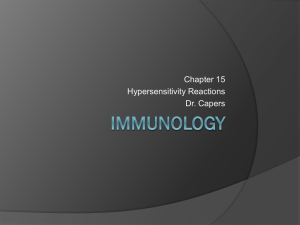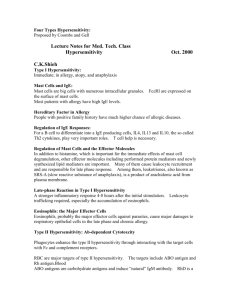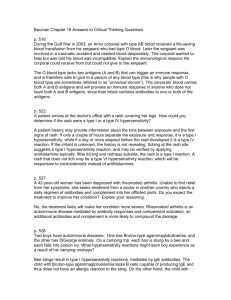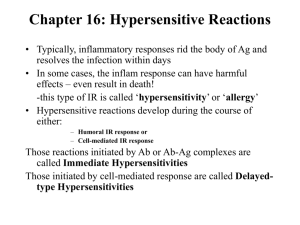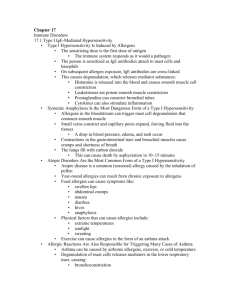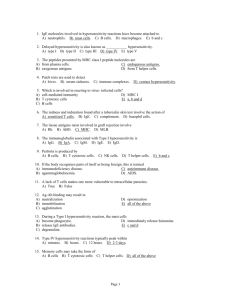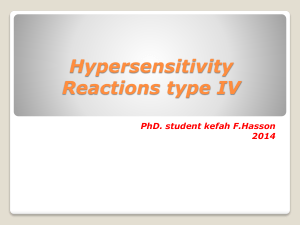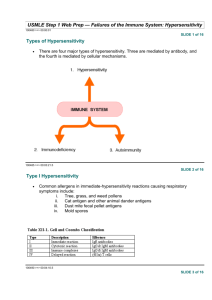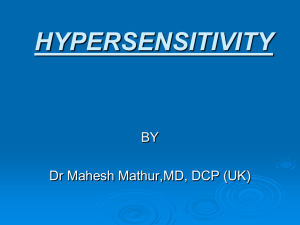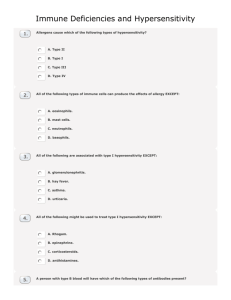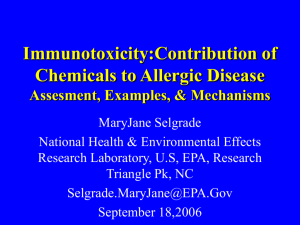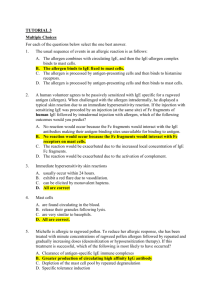Type II hypersensitivity target tissues
advertisement
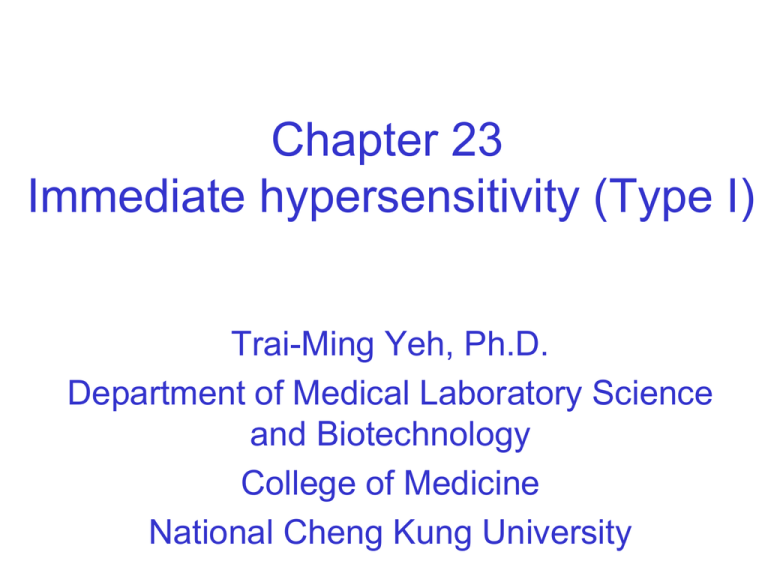
Chapter 23 Immediate hypersensitivity (Type I) Trai-Ming Yeh, Ph.D. Department of Medical Laboratory Science and Biotechnology College of Medicine National Cheng Kung University HYPERSENSITIVITY REACTIONS ARE BASED ON THE CLASSIFICATION OF COOMBS AND GELL Type I: Immediate hypersensitivity responses Type II: Antibody-mediated reactions Type III: Immune complexes Type IV: Cell-mediated reactions Anaphylaxis and urticaria wheal and flare skin response MOST ALLERGENS ARE PROTEINS IgE is distinct from other immunoglobulin • IgE has four constant regions of heavy chain • IgE can bind to high-affinity IgE receptors, FcεRI on mast cells and basophils and lowaffinity FcεRII (CD23)on B cells • The half-life of IgE is short (less than 2 days) compared with that of other immunoglobulins IgE is digest in endosome while IgG is protected by binding to the neonatal Fc gamma receptor, FcγRn TH2 Cytokines regulate the production of IgE TH2 cytokines: L-4 (IL13) IL-5 IL-10 Both IgE and IgG4 are dependent on IL-4 Tolerance to allergen by inducing IgG4 blocking antibody (hyposensitization) Small quantities of inhalant allergens cause hayfever, chronic rhinitis, and asthma Mast cells and basophils contain histamine which is released during degranulation Mucosal mast cells (MMCs) and connective tissue mast cells (CTMCs) have distinct granule proteases In allergic individuals mast cells can be recruited to the skin and to the nose Cross-linking of two FcεRI receptors results in degranulation and the synthesis of newly formed mediators MULTIPLE GENES HAVE BEEN ASSOCIATED WITH ASTHMA IN DIFFERENT POPULATIONS Skin test are used for diagnosis and investigation Skin tests • Prick test: 25-gauge needle, 0.1 μl of extract into the dermis • Intradermal injection 0.02-0.03 ml • Patch test :10 μg allergen is applied on a gauze pad 2.5 cm2, and the biopsy is carried out at 24 or 48 hours. SEVERAL DIFFERENT PATHWAYS CAN CONTRIBUTE TO THE CHRONICITY OF SYMPTOMS OF ALLERGY Corticosteroids, which are an effective treatment for most of the inflammation in asthma act at both stages ALLERGENS CONTRIBUTE TO ASTHMA • Bronchoalveolar lavage (BAL) analysis after allergen challenge demonstrates mast cell and eosinophil products • Major basic protein (MBP) is present in biopsies of the lungs and can produce epithelial change typical of asthma in vitro. • Non-specific bronchial hyperreactivity (BHR) is a major feature of asthma • Nasal smear eosinophils are increased Immunotherapy (or hyposensitization) is an effective treatment for hayfever NEW APPROACHES FOR TREATING ALLERGIC DISEASE • Modified forms of allergen-specific immunotherapy. • Adjuvants shift immune response to TH1 • DNA vaccine • Humanized monoclonal anti-IgE • Recombinant soluble IL-4R to block the biological activity of IL-4 • Humanized monoclonal anti-IL-5 decreases circulating eosinophils Summary of Chapter 23 Immediate hypersensitivity (I) • Hypersensitivity reactions are based on the classification of Coombs and Gell. • Historical observations have shaped our understanding of immediate hypersensitivity. • Most allergens are proteins. • IgE is distinct from the other dimeric immunoglobulins. • Allergens are the antigens that give rise to immediate hypersensitivity and contribute to asthma. • Mast cells and basophils contain histamine. • Multiple genes have been associated with asthma in different populations. Summary of Chapter 23 Immediate hypersensitivity (II) • Skin tests are used for diagnosis and investigation. • Several different pathways contribute to the chronic symptoms of allergy. • Allergens contribute to asthma. • Immunotherapy can be used for hayfever and anaphylactic sensitivity. • New approaches are being investigated for treating allergic disease. • IgE antibodies play a critical role in defense against helminths. 97年1月11日有一新聞報導衛生署核准的非類固醇 類止痛劑「Ketorolac」,自民國八十七年迄今, 國內「藥品不良反應通報系統」已有數十起有關 Ketorolac類藥物通報案件,已發生七例病人注射 含Ketorolac成分注射劑後產生過敏性休克案例, 其中四例更因此死亡。因此衛生署要求加註警語, 提醒醫護人員使用注射劑型Ketorolac成分藥品時, 需有急救設備備用,注射後半小時內應有人監控 病患的安全性。請說明此現象的免疫反應的機制, 就標示的重點回答。 Chapter 24 Hypersensitivity (Type II) Trai-Ming Yeh, Ph.D. Department of Medical Laboratory Science and Biotechnology College of Medicine National Cheng Kung University Type II hypersensitivity is mediated by IgG or IgM binding to specific cell surface and extracellular antigens 1. Cells engage their targets using Fc and C3 receptors 2. Cells damage targets by exocytosis of their normal immune effector molecule 3. When the target is host tissue that has been sensitized by antibody, the result is damaging 1. Ab against blood group Ag causes transfusion reactions 2. Cross-matching ensures that a recipient does not have antibodies against donor erythrocyte. ABO blood group system is of primary importance Genes coding for enzymes that transfer terminal sugars to a carbohydrate backbone cause the different blood group ABO The Rhesus system is a major cause of hemolytic disease of the newborn (hemolytic disease of the newborn, HDNB) HDNB is due to maternal IgG reacting against the child's erythrocytes in utero Autoantibodies against RBC • Warm-reactive autoantibodies against Rhesus system antigens, including determinants of the RhC and RhE loci as well as RhD cause accelerated clearance of erythrocytes • Cold-reactive autoantibodies IgM against I Ag and fix complement strongly cause erythrocyte lysis by complement fixation Direct Coomb’s test (direct antiglobulin test, DAT); to detect incomplete Ab on RBC surface) Drug-induced reactions to blood components occur in three different ways Type II hypersensitivity target tissues • Antibodies against basement membranes (collagen type IV) produce nephritis in Goodpasture's syndrome • Pemphigus is caused by autoantibodies to an intercellular adhesion molecule desmoglein-1 and desmoglein-3, components of desmosomes Autoantibodies to neutrophil cytoplasmic antigens (ANCAs) • Cytoplasmic (c-ANCA against proteinase III) is associated with Wegener's granulomatosis • Perinuclear (p-ANCA against myeloperoxidase) Antibodies against acetylcholine receptors (AchR) in Myathenia gravis Ab against voltage-gated calcium channels or the synaptic vesicle protein synaptotagmin in Lambert-Eaton syndrome caused defective release of acetylcholine Summary of Chapter 24 Hypersensitivity (Type II) • Type II hypersensitivity is mediated by antibodies binding to specific cells. • Type II hypersensitivity reactions may target cells. • Hemolytic disease of the newborn. • Type II hypersensitivity reactions may target tissues. • The role of autoantibodies in disease is not always clear. • Cytotoxic antibodies are increasingly being used for therapeutic indications. Important points needed to understand after class • Understand the importance and the immunology of the IgE-mediated hypersensitivity. • Understand the diagnosis and treatment of allergy. • Understand the role of type II hypersensitivity in blood transfusion.
